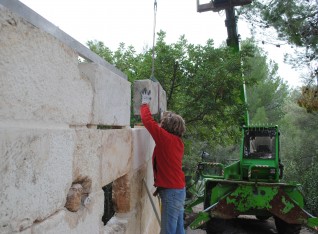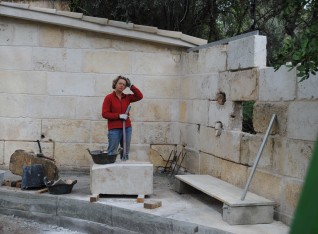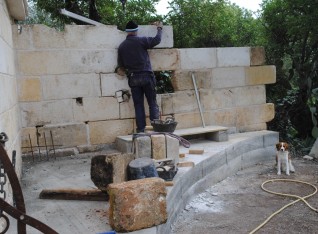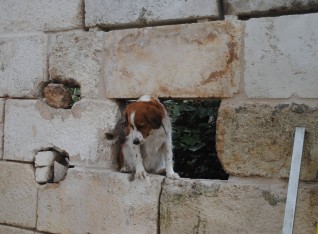Mares, picadis and marmolina
December 22, 2017Besides the vinoteca - on the right side - is a wall of blocks of limestone, called 'mares' in Spanish. Most old buildings, churches, fincas and many walls are made of this material which comes from local quarries on the island. I don't know much about the geological history of the Mallorca unfortunately, but you could state that the island sticks it's head above the sea because of it. The limestone layer has been build up over millions of years and you can see the fossil remains of shells and marine life clearly in certain types of mares. The most regular size of the blocks is 80 x 40 x 20 centimeter and they are heavy. I haven't weighed it yet, but I compare the weight with a bag of cement of 25 kg I guess it will be 3 times this weight, so 75 kg. I can lift it, but it's too heavy pick one up, put it on your shoulder and walk up and down stairs with it. But.... God gave us tools for assisting us with this and I thank him for this.
I don't know why this wall had been built by the mining company, but we wanted to restore it, as it had been broken down partly, probably by the former owner who needed blocks of mares. First we placed two pallets of blocks near the wall, then moved the telescopic crane to a strategic position and lifted the blocks one by one using straps (we did try a special custom made tool first, a kind of pair of scissors, but it was somehow displaced and did not jam the block tight in it's claws). We placed the block on small pieces of stone and made it stand level using jigs of wood and a big crowbar. We decided to not place more than 2 blocks on top of each other as it gets a bit wobbly. So after placing two rows of blocks we willed the gaps between the blocks with 'pasta'. Instead of using normal mortar made with sand as the main ingredient, I used marmolina, which is sawdust of marble. It becomes much harder than normal mortar (mixed with 5 parts of marmolina and 1 part of white cement plus water).




